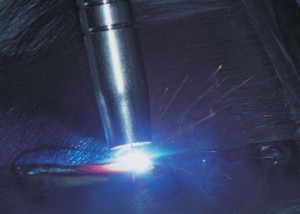If you want to learn the wonderful world of hobby welding so you can build those awesome DIY welding projects, in this article I’ll teach you the difference between MIG, TIG, and Stick welding so you can get started the right way.
All welding processes ultimately do the same exact thing, which is to fuse 2 metals together to make one piece. However, each welding process was created for a specific purpose.
The 3 main welding processes you need to know are called MIG (metal inert gas), TIG (tungsten inert gas), and Stick welding.
Each of these welding processes have a way of shielding the weld puddle from the atmosphere.
Without this shielding agent, you would end up with welds that are full of pinholes called porosity. Let’s look at how the weld puddle is shielded.
Welding Basics – What is Shielding Gas?
When you’re welding either one of 2 methods of shielding the weld will be used.
- Using Shielding Gas
- Using Flux

TIG uses a cylinder of argon to shield the gas, whereas MIG uses a mixture of 75% argon and 25% CO2.
You can get access to my free 4 day beginners guide to welding course if you’re serious about learning to weld as a hobby using the easiest welding process for beginners.
When you’re welding the gas will flow out of the TIG torch or the MIG gun and it will flow out at a rate fast enough to cover the weld puddle.
This gas purges the area so that no oxygen or nitrogen can contaminate the weld.
The great thing about using a shielding gas is that there is no slag produced like when using flux, so you end up with a nice clean weld.
What is Flux Used For When Hobby Welding?
As we talked about, flux is the other way of shielding the weld puddle. Flux is used when welding with the stick welding process, and when using flux core wire on a MIG welder.
Flux is simply a chemical agent that burns down and creates a shielding gas.
It’s the same thing as using a shielding gas, but flux creates a slag coating on top of the weld that needs to be chipped away.
Hobby Welding With A Stick Welder
The stick welding process has been around the longest out of all the arc welding processes. It’s still a very popular choice among hobbyists and industry.
Stick welding uses a long rod called an electrode. It contains the metal welding rod and it’s coated in flux.
When you strike an arc with a stick welder that welding rod burns down and creates the weld bead that you see when you look at a welded joint.
While it’s a tried and proven process, it can be undesirable for beginners to learn. Why?
- It can take forever to learn how to strike the arc
- It produces smoke
- You won’t pick it up as quickly
TIG Welding Isn’t So Good For Beginner’s Hobby Welding
When hobby welding you definitely don’t want to begin by buying a TIG welder.
The TIG process uses a torch that you start an arc with, and with the other hand you dip a filler rod to make the weld bead.
There is also a foot pedal you have to use to control the voltage. There are a lot of hobby welding enthusiasts who love using the TIG welder, but they’ve also mastered the other welding processes first.
TIG can take time to get good at, but once you’ve mastered it you can make very precise welds. You can weld metals as thin as a razor blade together.
If you tried doing that with the other welding processes you would burn right through.
MIG Welding Is The Quickest & Easiest Hobby Welding Process
When you’re trying to learn how to mig weld, you first need to know a few features of a mig welder.
MIG Welding uses a roll of wire, and the wire is fed out of the gun creating the actual weld bead. When you press the trigger and start the welding arc on a MIG welder the machine starts feeding out the wire.
You can use 2 kinds of wire when hobby welding with a MIG welder.
- Flux Core Wire
- Solid Wire
Like we talked about earlier, flux core wire uses flux as the shielding agent. It actually has the flux on the inside of the wire.
This produces slag on your welds, so if you don’t want to chip away slag then get you a C25 gas cylinder, a regulator, and some solid wire.
Solid wire is just that, it’s solid with no flux inside. You don’t need it since you have shielding gas.

